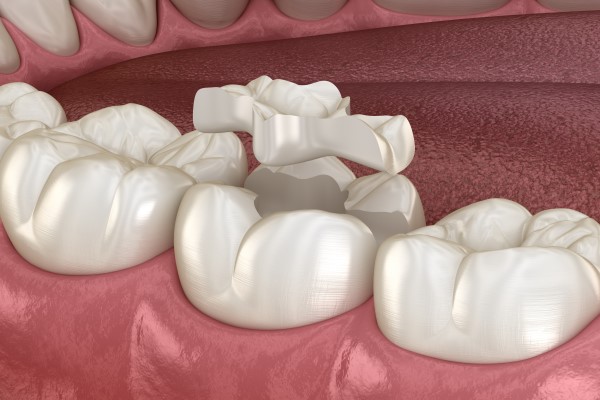A Step-by-Step Guide to Getting a Dental Inlay

A dental inlay is often necessary for teeth that are in bad shape, whether it be due to cavities or accidental injuries such as cracks or chips. However, among dental restorations, inlays are not the most common type. Most people are familiar with dental fillings or crowns, but general dentists also recommend dental inlays for additional types of problems. Because dental inlays are not as familiar to most people, it is a good idea to review how they work and what the process is like. Ready to learn more?
What are dental inlays?
Dental inlays are indirect dental restorations that are placed in between the cusps of a tooth. They are custom created in a dental lab, which requires patients to visit their dentist's office multiple times throughout the process. Dental inlays are typically made of composite resin or porcelain, depending on the patient's desire and the dentist's recommendation. Both materials can be made to match the patient's original tooth color, which makes for a discreet and aesthetically-pleasing restoration.
A step-by-step guide to dental inlay placement
During the first appointment, the dentist will numb the treatment area using a local anesthetic, ensuring the patient will feel little to no discomfort. Once the area is numb, the dentist will use a dental drill to remove dental decay from the tooth. If there is a crack or chip in the tooth, the dentist will use a different dental tool to smooth the surface of the tooth.
Then, the dentist will take an impression of the tooth that requires the dental inlay. Then, the impression will be sent off to the dental lab. The dentist will place a temporary seal over the treated tooth to protect it from bacteria while waiting for the permanent inlay.
Once the dental inlay is done, the patient will return to the dental office. The dentist will use dental cement to secure the inlay in place. A follow-up appointment may be required to ensure that the dental inlay fits and works as designed while remaining comfortable and healthy.
When dental inlays are needed
Dental inlays are typically recommended when a patient has a cavity that is too large for a dental filling. Additionally, they are recommended when the tooth doesn't have enough surface space for a dental crown to be used. Outside of cavities or tooth decay, dentists recommend inlays for patients that have minor cracks or chips in between the cusps of a tooth.
Reach out to our Mableton office today
Would you like to learn more about the dental inlay process? The Providence Family Dentistry is here to answer any questions you may have. Reach out to our Mableton office to learn more or to schedule a consultation.
Request an appointment here: https://www.providencefamilydentistry.com or call Providence Family Dentistry at (678) 496-7021 for an appointment in our Mableton office.
Check out what others are saying about our dental services on Yelp: General Dentistry Services in Mableton, GA.
Recent Posts
Not flossing regularly can increase the risk of developing oral health concerns, such as dental cavities and periodontal disease, so a general dentist encourages patients to floss several times a day and stick to a consistent oral care schedule to reduce the risk of oral health complications in the future. Flossing is essential to good oral…
If you find a cavity, you may make an appointment with your general dentist to fix it. However, there are some ways that you can reverse mild tooth decay. Fillings are not your only option if the cavity is still very small. Keep reading to learn more.Some studies have suggested that diet changes can reverse…
Despite your efforts at preventing tooth decay, sometimes your general dentist may detect one or two cavities. You may be tempted to postpone filling the tooth cavity because you do not feel any pain, but the delay can come at a cost. Cavities do not heal, and what starts as a simple issue may turn…
The most frequently visited health care provider is a general dentist. And there is a good reason for this — general dentistry is tailored towards the prevention of disease.A general dentist prevents, assesses, diagnoses and treats oral diseases. They also help maintain the appearance and function of the teeth. Sometimes, oral diseases can be a…


